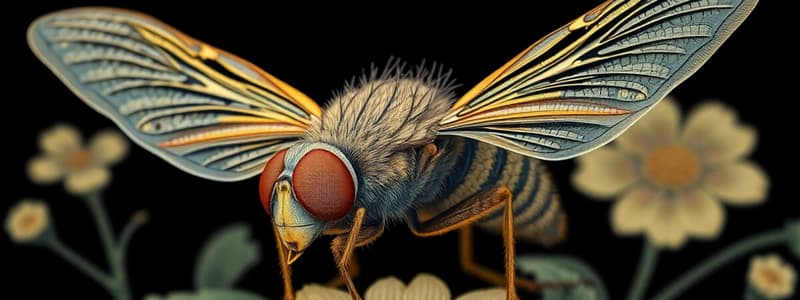Podcast
Questions and Answers
Which characteristic is used for identifying Chrysops spp.?
Which characteristic is used for identifying Chrysops spp.?
- Whisker-like antennae
- Short proboscis
- Dark bands across wings (correct)
- Sponging mouthparts
What is an effective control measure for Dipteran infestations?
What is an effective control measure for Dipteran infestations?
- Ignoring the infestation
- Minimizing manure management
- Feeding livestock during peak fly activity
- Using insect repellents on livestock (correct)
What is the primary site for egg laying in Melophagus ovinus?
What is the primary site for egg laying in Melophagus ovinus?
- In the host’s wool (correct)
- Decaying organic matter
- Fresh feces
- Wounds and secretions
Which disease is primarily transmitted by Culicoides spp.?
Which disease is primarily transmitted by Culicoides spp.?
Which statement about Oestridae pathogenesis is true?
Which statement about Oestridae pathogenesis is true?
What type of mouthparts do Tabanus spp. possess?
What type of mouthparts do Tabanus spp. possess?
What behavior do horses exhibit to avoid Chrysops spp. bites?
What behavior do horses exhibit to avoid Chrysops spp. bites?
What is a common characteristic of Hypoderma spp. in terms of their lifecycle?
What is a common characteristic of Hypoderma spp. in terms of their lifecycle?
Which treatment is effective against early stages of Hypoderma spp. infestation?
Which treatment is effective against early stages of Hypoderma spp. infestation?
What economic impact do 3rd instars of Hypoderma spp. cause?
What economic impact do 3rd instars of Hypoderma spp. cause?
What is a key clinical sign of Hypoderma spp. infestation in cattle?
What is a key clinical sign of Hypoderma spp. infestation in cattle?
Which species is known as the sheep nasal bot?
Which species is known as the sheep nasal bot?
What is the primary method of control for Melophagus ovinus in animals?
What is the primary method of control for Melophagus ovinus in animals?
During which life stage does Melophagus ovinus adhere to the fleece of sheep?
During which life stage does Melophagus ovinus adhere to the fleece of sheep?
What is a characteristic feature of mosquitoes from the Culicidae family?
What is a characteristic feature of mosquitoes from the Culicidae family?
What type of parasitism do Cuterebra spp. exhibit?
What type of parasitism do Cuterebra spp. exhibit?
What is one potential clinical sign of Cuterebra spp. infestation in a host?
What is one potential clinical sign of Cuterebra spp. infestation in a host?
Which of the following best describes the larvae of dipteran flies in the context of myiasis?
Which of the following best describes the larvae of dipteran flies in the context of myiasis?
What is one of the primary health risks associated with the transmission of diseases by Culicidae?
What is one of the primary health risks associated with the transmission of diseases by Culicidae?
How is the life cycle of Melophagus ovinus characterized?
How is the life cycle of Melophagus ovinus characterized?
What are the mouthparts of adult Oestridae characterized by?
What are the mouthparts of adult Oestridae characterized by?
Which factors determine the visibility of instars of Melophagus ovinus on fleece?
Which factors determine the visibility of instars of Melophagus ovinus on fleece?
Flashcards are hidden until you start studying
Study Notes
House Fly
- Common name: House fly
- Hosts: Animals and humans
- Size: 5.5-7.5 mm
- Mouthparts: Sponging
- Eggs laid in: Animal manure and decaying organic materials
Face Fly
- Common name: Face fly
- Hosts: Animals and humans
- Feed on: Animal secretions and wounds
- Eggs laid in: Rotting organic materials
- Eye disorders: Conjunctivitis
- Vector of: Draschia megastoma and Habronema
Stable Fly
- Common name: Stable Fly or Biting House Fly
- Hosts: Animals and humans
- Mouthparts: Suitable for blood taking
- Position when resting: Sits on walls with its head facing up
- Eggs laid in: Decaying matter, like damp hay
- Do not: Treat compost
Horn Fly
- Common name: Horn fly
- Hosts: Cattle
- Size: Half the size of a house fly
- Position when resting: Swarms around horns after feeding; rests on back in swarms; at abdomen when rained on
- Eggs laid in: Fresh feces
- Treatment: Treat the host
Biting Midges
- Common name: Biting midges or "no-see-ums"
- Hosts: Animals and humans
- Mouthparts: Short, piercing proboscis
- Bite: Painful
- Biological vector of: Several pathogens
Tabanids
- Common name: Horse fly
- Hosts: Large domestic or wild animals, humans, small mammals, birds
- Size: Stout-bodied fly, 10 to 25 mm
- Mouthparts: Slashing and sponging
- Pathogenesis and lesions: Painful bites
- Efficient mechanical vectors of: Several diseases
- Clinical signs: Annoyance
- Diagnosis: Identify the fly
- Treatment and prevention: Cannot control via breeding sites; control in housing and on animals (use repellents, insecticides)
Deer Fly
- Common name: Deer fly
- Identification: Dark bands across wings, elongate antennae
- Bite: Horses in shaded areas
- Horses will: Stand in the sun to avoid bites
- All other aspects are like: Tabanus spp.
- Diagnosis: Identify the fly. Deer flies prefer shade.
- Treatment and prevention: Cannot control via breeding sites; control in housing and on animals (use repellents, insecticides)
Melophagus ovinus
- Host: Sheep
- Identification: Dorsoventrally flattened, hairy, wingless dipteran; blood sucking mouthparts
- Site(s) of infestation: Wool
- Life cycle: Female produces one egg that hatches inside her body; third instar adheres to fleece; immobile instars pupate (3-4 mm) and are visible on fleece; adults emerge in 3 weeks in summer, longer in winter.
- Diagnosis: Fly identification
Mosquitoes
- Common name: Mosquitoes
- Identification: Pair of wings, long thin legs, long proboscis, long antennae
- Genera: 43
- Pathogenesis and lesions: Transmit many diseases and pathogens
Myiasis
- The infestation of: Living animals with the larvae of dipteran flies
- Types of myiasis: Obligatory (cannot survive without a host); Facultative (optional)
Oestrids
- Adults: Large hairy flies with nonfunctioning mouthparts; short-lived
- Larvae: Obligatory parasites; host-specific
- Examples: Cuterebra, Hypoderma, and Oestrus
Cuterebra spp.
- Common name: Rodent or rabbit bot fly
- Hosts: Rodents, rabbits, squirrels, chipmunks, mice, dogs, cats. Zoonotic.
- Identification: Third instar and season (spring and summer)
- Site(s) of infestation: Subcutaneous connective tissue, can locate in nasal and oral regions, and migrate to brain.
- Pathogenesis and lesions: Fibrotic cyst forms from instar in subcutaneous tissue. Instar in the brain of a cat can lead to infarction
- Clinical signs: Lump in neck, fur constantly wet, hole drips fluid.
- Diagnosis: Instar can be removed whole. Type 1 hypersensitivity type reaction. Wound heals slowly.
- Treatment and prevention: Several remedies may protect, but are not approved.
Hypoderma spp.
- Common name (adults): Warble fly, heel fly, ox warble; Common name (in star): Cattle grub
- Hosts: Cattle
- Identification: Typical oestrid.
- Life cycle: H. lineatum eggs laid in lines of 6 or more on the lower limb; adults active in early summer; H. bovis eggs laid singly; adults active in late summer.
- Life cycle (continued): Overwinter as a first instar; H. lineatum accumulates in the submucosa of the esophagus; H. bovis accumulates in the epidural fat of the spinal cord.
- Site(s) of infestation: Third instars found in lumps (warbles) on the backs of cattle in spring.
- Pathogenesis and lesions: Third instars under the skin cause damage and downgrade carcasses, causing economic loss; H. lineatum death can lead to bloat; H. bovis toxins can lead to paraplegia.
- Clinical signs: Faulty regurgitation, bloat, paraplegia.
- Diagnosis: Identification of the parasite
- Treatment and prevention: Macrocyclic lactones (MCLs) kill early stages; timing: late summer or early fall
Oestrus ovis
- Common name: Sheep nasal bot, warble fly of sheep
- Hosts: Sheep
- Life cycle: Eggs laid in the nostrils of sheep; larvae migrate to the sinuses; mature larvae drop to the ground; pupate in the soil; the cycle continues.
- Clinical signs: Sneezing, nasal discharge, head shaking, and poor weight gain
- Diagnosis: Detection of larvae in the nasal passages; observation of the fly near the sheep.
- Treatment: Ivermectin or moxidectin; apply as a pour-on or injectible. Prevented by good hygiene and the use of repellents.
Studying That Suits You
Use AI to generate personalized quizzes and flashcards to suit your learning preferences.




